
|
Features
|
|
|
|
Books
|
|
|
|
Fun & Games
|
|
|
|
Contact Us
|
|
|
John's Journal... Entry 188, Day 3
MARK DRURY'S TURKEY-HUNTING TACTICS
A North Missouri Turkey Hunt
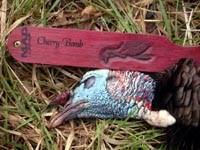 EDITOR'S
NOTE: Longtime, expert turkey caller and hunter
Mark Drury of Columbia, Missouri, the creator and founder of M.A.D. calls,
also produces videos for Drury Outdoors, "Outdoor Life" and other well-known
outdoor companies.
EDITOR'S
NOTE: Longtime, expert turkey caller and hunter
Mark Drury of Columbia, Missouri, the creator and founder of M.A.D. calls,
also produces videos for Drury Outdoors, "Outdoor Life" and other well-known
outdoor companies.
QUESTION: What kind of terrain are we hunting?
ANSWER: It's a mix of rolling timbers and pastures.
QUESTION: Mark, the weather was cold and the wind was
blowing where we were hunting. Why did you choose this location?
ANSWER: The day's temperature was 41 degrees with a 25 mile-per-hour northwest
wind, which were the worst conditions you could have for a morning hunt.
I had to think about the places I knew the turkeys would be hanging out,
despite the weather. Chances are in bad weather, you're not going to hear
anything, which is why you've got to figure out where the birds are in
the rain.
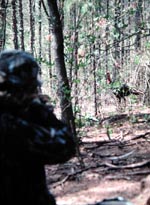 QUESTION:
Usually a turkey will come to a high place to strut and drum and gather
his hens. Why did you choose to stake out a low-bottom field?
QUESTION:
Usually a turkey will come to a high place to strut and drum and gather
his hens. Why did you choose to stake out a low-bottom field?
ANSWER: I chose a low-bottom field to stay out of the wind.
QUESTION: Tell me about this field where you located
the turkeys.
ANSWER: I saw them at different times of the day over a three-day period.
I'd heard them early in the morning, so that told me they were going there
early and then strutting up later in the day to where I'd see them.
QUESTION: What happened when we set up on the edge of
that low-bottom field?
ANSWER: We set up where I thought the turkeys would come in and gobble.
As we were getting set up, we bumped into three hens, which let us know
a gobbler was nearby. We had confidence the turkeys would be there. I
waited until enough light arrived that I could make a turkey gobble. I
yelped softly, and he gobbled immediately from 100 yards in front of us.
That was a perfect place to hunt as far as I'm concerned.
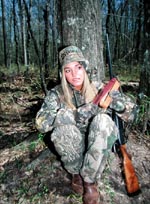 QUESTION:
What did you do after seeing the turkey 100 yards away?
QUESTION:
What did you do after seeing the turkey 100 yards away?
ANSWER: I got out the camera and started filming. My brother Terry Drury
and I have been filming and producing videos for our company Drury Outdoors
since 1989.
QUESTION: What did you see through the camera lens?
ANSWER: I could see you sitting to my right. I could see the connection
to the field and the decoy. I panned-out the whole scene and then swung
over and finally got the turkey coming off the hill. He came in slowly
and cautiously because of the wind. The 2-year-old tom was just a little
shy.
QUESTION: When the turkey got on the hill and started
to strut and drum, we began to hear another turkey behind us in the distance
coming toward us. Did you expect that second turkey to come in as the
turkey on the hill was coming over?
ANSWER: This low-bottom field was a meeting place for turkeys, and I expected
him to come in to where we were. I felt like we were in good shape.
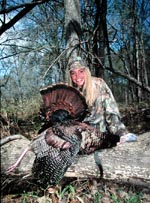 QUESTION:
Sometimes you can get focused on one turkey and forget about the second
turkey?
QUESTION:
Sometimes you can get focused on one turkey and forget about the second
turkey?
ANSWER: It's easy to do that. You're lucky if they're gobbling.
QUESTION: The first turkey stopped about 80- to 90-yards
away. What did you do?
ANSWER: I yelped at him twice with my mouth yelper.
QUESTION: The turkey still didn't come closer, so you
switched calls. Why did you go from a diaphragm call to a box call?
ANSWER: A box call is a little clearer than a diaphragm, and I think the
sound pierces better. He responded to that pitch really well.
QUESTION: The turkey came down the hill and then what
happened?
ANSWER: The turkey came down, and once he got a visual of the field, he
could see the decoy. He stood there and looked at it a long time. He finally
decided it was a real hen, and he started picking and strutting and heading
our way. I came out from the bushes and made the shot.
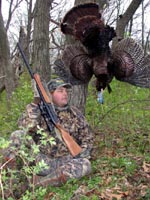 QUESTION:
Why did you call the shot when you did?
QUESTION:
Why did you call the shot when you did?
ANSWER: He was coming, and his body posture was slick-down and calm. He
was walking horizontally, which is what I like.
QUESTION: Can you tell me five tricks for hunting turkeys
in the rain?
ANSWER: Just remember to ...
* switch to friction calls rather than use mouth calls.
You can hear a friction call at a much greater distance, especially in
the rain.
* reduce your expectations for gobbling. Understand a rainy day is not
a good-bird day. The turkeys won't gobble, and they aren't in a good mood.
They're cold and hungry. They're going to go near a food source, which
is where the hunter needs to be.
* depend on your binoculars. You've got to find strutters that are close.
You've got to depend on visual signs rather than on audio signs. The turkeys
will be visible in the rain. They get nervous in the rain, and they like
to leave the woods. They like to go out to open fields and find fresh
bugs that come with a rain.
* cover the hunting ground slowly and methodically. You've got to patiently
look for your turkeys where you think they may be visible. You won't be
able to call to find them because the birds won't gobble back as much
in the rain.
* make sure you dress for the weather. If it's raining, wear rain gear
so you can stay out in the woods. If it's cold, make sure you've got proper
gear to stay out and keep warm. You can't expect a turkey to show up right
away. You've got to be patient and weather the storm. To do that, you've
got to have the right clothes.
To learn more about hunting turkeys and the experts' tactics, click here.
TOMORROW: MORNING HENNING AND GOBBLING
Check back each day this week for more about MARK DRURY'S TURKEY-HUNTING TACTICS ...
Day 1 - Turkey Hunting in
the Rain
Day 2 - Don Shipp's Tips For Calling Turkeys
In The Rain
Day 3 - A North Missouri Turkey Hunt
Day 4 - Morning Henning and Gobbling
Day 5 - Afternoon Hunting